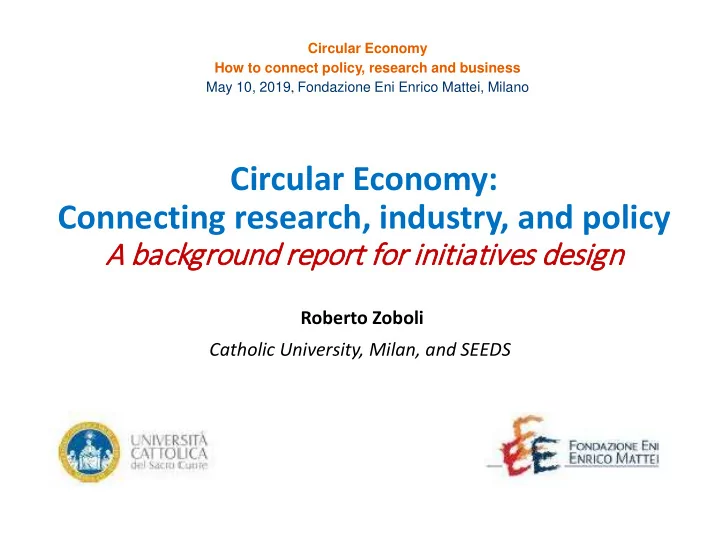

Circular Economy How to connect policy, research and business May 10, 2019 , Fondazione Eni Enrico Mattei, Milano Circular Economy: Connecting research, industry, and policy A background report f t for i initi tiati tives d design Roberto Zoboli Catholic University, Milan, and SEEDS
The report • Aim: Background for strategies/initiatives on the CE • Part 1: Taking stock of the knowledge base: 1. Conceptual frameworks 2. Evolving policy framework 3. Quantifications 4. Innovation 5. Selected initiatives Europe – Italy • Part 2: Directions to expand the knowledge base 1. CE as an ‘Innovation System’ 1. NEXUS: CE - Decarbonisation – Bioeconomy 2. Open ‘economics’ issues 2
Features • Focus: CE knowledge base for industry-policy connection (gaps) • Thread: ‘Old CE’ and ‘New Innovation-based CE’: • ‘CE Package 2015-2018’ a demarcation line? • Innovation/industrial policies a new major driver? • European scope, Italian examples: EU-level drivers/processes • Selective in Part 1, especially on ‘Conceptual frameworks’ and ‘Initiatives • Preliminary in Part 2 3
Part 1: Taking stock of the CE knowledge base 1. Concepts and ideas on the CE 2. Policy drivers 3. Quantifications 4. Innovation for the CE 5. Selected initiatives 4
1. Concepts and ideas on the CE • Ellen MacArthur Foundation 2012 • Bochen et al. 2016 and OECD 2017 • Waste hierarchy (Lansink’s Ladder 1970s) • EEA 2015 • Academic research 5
2. Policy drivers • P1: The EU Waste Hierarchy • P2: Extended producer responsibility (EPR) • The revised directives on waste and the Plastics Strategy (2018) • The CE and the revision of the Bioeconomy strategy (2018) • The CE in the ‘Carbon- neutral economy 2050’ strategy (2018) • Section 6: NEXUS 6
3. Quantifications • Waste statistics • Joining waste statistics and LCA data • The European Reference Model for Waste • Material Flow Accounts • The Eurostat CE indicators • Closing the circle: Input output data, EEIO, and other models 7
4. Innovation for the CE • Evidence on patents for the CE • Evidence on CE innovation adoption by enterprises • Evidence on CE organisational innovation: compliance schemes in EPR value-chains • Section 6: ‘Innovation system’ 8
5. Selected initiatives • Ellen MacArthur Foundation https://www.ellenmacarthurfoundation.org/ • EEA – European Environment Agency https://www.eea.europa.eu/ • European Circular Economy Stakeholder Platform https://circulareconomy.europa.eu/platform/ • MATTM, ENEA, ICEP (Italy) https://www.minambiente.it/pagina/economia-circolare • Circular Economy Network, Istituto per lo Sviluppo Sostenibile (Italy) https://circulareconomynetwork.it/ • Confindustria (Italy) http://economiacircolare.confindustria.it/ • ASviS (Italy) http://asvis.it/# • Lombardy Region (Italy) http://www.regione.lombardia.it/wps/portal/istituzionale/HP/lo mbardia-notizie/DettaglioNews/2018/10-ottobre/22- 28/cattaneo-insediato-osservatorio/cattaneo-insediato- osservatorio 9
A few points from Part 1 • Overload of definition/conceptualisation work: useful? • Shortage of quantifications based on ‘circular’ analytical tools • Innovation: • (i) many stories of ‘CE business models’ and micro-innovations: what macro-implications? • (ii) scope of relevant innovations: to be redefined (beyond waste)? • Hundreds of micro-initiatives: all relevant, credible, useful? 10
Part 2: Future directions Enlarging the CE knowledge-base to connect research, industry, and policy 1. Looking at the CE as an ‘innovation system’ 2. A NEXUS approach: Linking CE, decarbonisation, and bioeconomy 3. Other open economic issues 11
Waste system/policy: Innovation view • Prevention innovation (e.g. dematerialising) • Micro-level invention and innovation (e.g. chemical recycling) • Management-option innovation (technology diffusion, moving to ‘Zero landfill’) • Organisational innovation (e.g. EPR schemes) • Policy and market drivers, and feedbacks 12
A broader CE-innovation perspective 13
The ‘Sectoral/National Innovation Systems’ approach A National System of Innovation (OECD 1999) and example of a Sectoral System of Innovation (for ICT sector) 14
‘New Innovation-based CE’: Pushes from EU R&I policy (H2020, HE, MAFF) H2020 Work Programme 2018-2020: Components of the Focus Area - 'Connecting economic and environmental gains – the Circular Economy' Component Budget Leadership in enabling and industrial technologies - €370 million Nanotechnologies, Advanced Materials, Advanced Manufacturing and Processing, and Biotechnology (LEIT-NMBP): European high-tech building blocks serving the circular economy (Sustainable Process Industries (SPIRE) initiative) Societal Challenge 2 'Food security, sustainable €256 million, including €100 million for access to risk agriculture and forestry, marine, maritime and inland finance water research, and the bioeconomy' (SC2): the bio- economy aspects of the circular economy Societal Challenge 3 'Secure, clean and efficient €12 million energy' (SC3): reuse of carbon dioxide Societal Challenge 5 'Climate action, environment, €326 million resource efficiency and raw materials' (SC5): transition to circular economy business models and practices, and sustainable sourcing or raw materials, also from secondary sources Source: adapted from EC H2020 Work Programme 2018-2020 15
Part 2: Future directions 1. Looking at the CE as an ‘innovation system’ 2. A NEXUS approach: Linking CE, decarbonisation, and bioeconomy 3. Other open economic issues 16
A NEXUS for the CE • Interconnections: conventional sectoral approaches not effective or not efficient • NEXUS approach: overcome fragmentation/separation of sectoral policies in systemic problems • CE – Decarbonisation - Bioeconomy: interconnections often recognised/cross-referenced, but still separate strategies/policies/transitions with own scopes, objectives, instruments • ….. but companies/industries operate in a NEXUS framework 17
A sketch of the CE-DEC-BIO NEXUS 18
Example: Energy from waste, RES and biomass • ‘Waste-to-energy’ is increasing • Energy from biomass and ‘renewable waste’ 65% of total RES consumption (2016) • Pressures on biocapacity: CE can reduce 19
Example: Circular bioeconomy 20
Part 2: Future directions 1. Looking at the CE as an ‘innovation system’ 2. A NEXUS approach: Linking CE, decarbonisation, and bioeconomy 3. Other open economic issues 21
Weak knowledge on the ‘economics’ of the CE • Weak incentives to CE/RE from commodity market prices • Policies (and people) have a central role • Limited information on micro-economics of recycling/secondary materials • Limited use of MBI and price-based policies, mainly EPR • Limited knowledge on capacities (treatment, recycling, trade) • Investment needs and finance for the CE 22
Comments and suggestions? • How to expand/improve the knowledge base for industry-policy connection? • Is the ‘Innovation System’ approach useful? • Is the NEXUS approach useful? • How to fill knowledge gaps on the ‘(micro)economics’ of the CE? 23
Recommend
More recommend